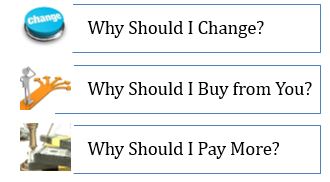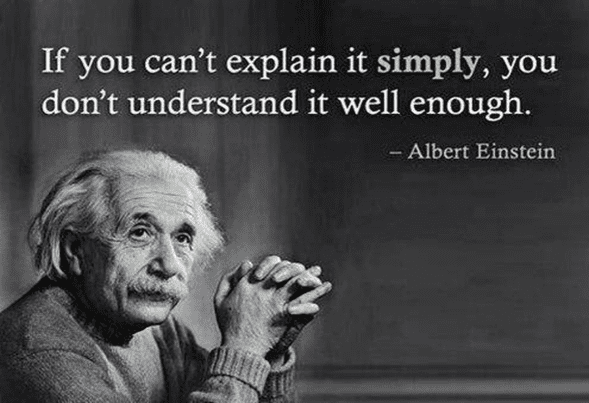Picture a customer conversation. There are 3 questions a potential customer will naturally ask:
 Why should I change?
Why should I change?- Why should I buy from you?
- Why should I pay more?
How would you answer? How do your sales reps answer?
Value Selling. Sales teams who answer these questions based on customer value engage in a conversation with customer stakeholders about what your solution can do for them. Value selling helps to establish the reason for a customer to change at all, providing content to address the risk-averse buyer’s temptation to stay with the status quo and revert to “no decision.” Value selling points directly toward how you support your customer’s goals. It positions your differentiation, supporting your case and your price premium vs low-cost providers.
Answers based on customer value are inherently customer-centric. Sales teams who tailor their value answers specifically to the customer make their customer interactions more relevant. Framing responses to customer questions with the value you create focuses conversations on outcomes, making those discussions delivery-centric.
 Value selling delivers sales success. Forrester Research, surveying buyers, found that “the first vendor to succeed in communicating a vision to executives wins the business 74% of the time.” The key to that win rate, according to Forrester, is that the winning vendor works with the buyer to turn the vision into “a clear path to value.” CRM data from organizations adopting value selling show that opportunities, where a Value Proposition is used (1), have 5-15% higher win rates and (2) 5-25% higher price outcomes.
Value selling delivers sales success. Forrester Research, surveying buyers, found that “the first vendor to succeed in communicating a vision to executives wins the business 74% of the time.” The key to that win rate, according to Forrester, is that the winning vendor works with the buyer to turn the vision into “a clear path to value.” CRM data from organizations adopting value selling show that opportunities, where a Value Proposition is used (1), have 5-15% higher win rates and (2) 5-25% higher price outcomes.
Who Already Gets It in Your Organization? The case for value selling is clear. Prioritizing it is a question in many organizations. Champions and potential advocates of value selling are present in most commercial teams focused on innovative products or solutions. They come from many backgrounds and many perspectives:
- Six sigma black belts and others charged with process improvement in marketing and sales.
- Pricing professionals trained in value-based pricing.
- Alumni from some of the great value-centric organizations of the last 2 or 3 decades.
- Followers of the many value strategy thought leaders and consultants.
- Field marketing and sales enablement professionals.
- Sales team members who have found a need for value discussions with their customers or who have come up with value presentations and seen their results.
These potential advocates don’t necessarily have sales experience or sales leadership responsibilities. They may or may not have an influence on sales leadership or marketing leadership. Many of them have been using value analysis in their day jobs in making commercial pricing and offering design decisions based on value. There are product management, marketing, and pricing professionals who routinely monitor differentiated value for new and important existing products, sometimes as a best practice and sometimes based on organizational disciplines. There are internal consultants who help product launch teams do value-based research and analysis. Finally, there are product management and marketing leaders with influence who impose value-based disciplines in their regular management decision-making processes even if they aren’t responsible for sales execution.
All of these champions and advocates understand the potential impact of value selling to the organization as a whole but may lack the influence, the energy, or possibly the courage to drive organizational change in their sales process and sales teams. Sales leadership time and bandwidth are scarce and most sales leaders are under significant immediate pressure to implement other initiatives while hitting aggressive targets.
 6 Ways to Broaden and Elevate Value Awareness and Value Selling. But there are ways to raise awareness of the potential of value selling. They all start with good Value Proposition content that highlights the delivery of value to the customer. That content, when well-presented internally, invites everyone in the organization to envision the value conversation that would doubtless improve a conversation with buyers making significant purchase decisions.
6 Ways to Broaden and Elevate Value Awareness and Value Selling. But there are ways to raise awareness of the potential of value selling. They all start with good Value Proposition content that highlights the delivery of value to the customer. That content, when well-presented internally, invites everyone in the organization to envision the value conversation that would doubtless improve a conversation with buyers making significant purchase decisions.
One objective is to find a C-suite sponsor who makes value a regular and required discipline in product launch or product management. A second objective is to find a C-suite sponsor willing to talk the talk, who works a value proposition for important new products into a 30-second elevator pitch used regularly in investor calls and interviews by Wall Street journalists. The ultimate objective is to find a C-suite sponsor with the power to change sales priorities and to draw sales attention to compelling value content. Here are six ways to identify and mobilize organizational sponsorship that can drive sales initiatives.
-
- Invite and motivate the development of strong Value Proposition content.
 Value selling requires great content. Talented product managers should be encouraged and incentivized to understand and discuss the business case for their customers to buy their product. Product managers should be challenged to present their product’s customer value. Product leadership should ask for a Value Proposition in stage-gate reviews and product launch processes. They should require value updates in annual product planning processes and price reviews. Customer value should be part of offer design and segmentation discussions. Product leaders should expect Value Propositions and case studies to be included in marketing collateral. They should feature Value Propositions in product launch meetings and in the product-centric portions of annual sales meetings. A product leader’s refrain should start as “what do we do for our customers?” and should evolve into “why would our customers buy our products at the prices we are trying to obtain?”
Value selling requires great content. Talented product managers should be encouraged and incentivized to understand and discuss the business case for their customers to buy their product. Product managers should be challenged to present their product’s customer value. Product leadership should ask for a Value Proposition in stage-gate reviews and product launch processes. They should require value updates in annual product planning processes and price reviews. Customer value should be part of offer design and segmentation discussions. Product leaders should expect Value Propositions and case studies to be included in marketing collateral. They should feature Value Propositions in product launch meetings and in the product-centric portions of annual sales meetings. A product leader’s refrain should start as “what do we do for our customers?” and should evolve into “why would our customers buy our products at the prices we are trying to obtain?”
- Invite and motivate the development of strong Value Proposition content.
-
- Include Value Propositions in internal decision-making presentations as if presenting to customers.
 Validated calculators and exact spreadsheets of customer value represent good outcomes, but so often it is tempting for the product team to breathe a sigh of relief and consider their work done once the math is right. Resist this temptation. Require analytical product managers to present their value analyses as if they are explaining what your product does to the buyer’s C-suite. Logical exactness is good. Clarity and simplicity are better. Embedding clear and simple reasons to buy in a narrative or case study about customer success, that includes the math, is the best of all. Preferably in words of one syllable.
Validated calculators and exact spreadsheets of customer value represent good outcomes, but so often it is tempting for the product team to breathe a sigh of relief and consider their work done once the math is right. Resist this temptation. Require analytical product managers to present their value analyses as if they are explaining what your product does to the buyer’s C-suite. Logical exactness is good. Clarity and simplicity are better. Embedding clear and simple reasons to buy in a narrative or case study about customer success, that includes the math, is the best of all. Preferably in words of one syllable.
- Include Value Propositions in internal decision-making presentations as if presenting to customers.
-
- Present great Value Propositions internally to best practice groups and commercial excellence forums.
 Large enterprises have learned that their best people in various parts of their organization come up with best practices that can and should be disseminated for adoption more broadly. They systematize the discussion and propagation of best practices organization-wide in Marketing Councils, Product Management Forums, Pricing Working Groups and Commercial Excellence Boards. Capitalize on these assemblies for improvement by going beyond the theory of value-based pricing. Show strong specific Value Propositions in these meetings. Speak about how they have been created and validated. Highlight uses with alpha customers and beta customers heading into a product launch. Case studies help. Success stories are crucial.
Large enterprises have learned that their best people in various parts of their organization come up with best practices that can and should be disseminated for adoption more broadly. They systematize the discussion and propagation of best practices organization-wide in Marketing Councils, Product Management Forums, Pricing Working Groups and Commercial Excellence Boards. Capitalize on these assemblies for improvement by going beyond the theory of value-based pricing. Show strong specific Value Propositions in these meetings. Speak about how they have been created and validated. Highlight uses with alpha customers and beta customers heading into a product launch. Case studies help. Success stories are crucial.
- Present great Value Propositions internally to best practice groups and commercial excellence forums.
-
- Brief C-suite executives with the elevator pitch version of your Value Proposition.
 Product launch briefings to the C-suite are critical moments for up-and-coming product managers. Whether or not a 60-slide briefing book is an organizational habit, the executive summary of any materials should highlight the Value Proposition for the product. In internal oral presentations, lead with the Value Proposition. Customer value highlights the clarity of the team’s thinking. It puts customers front and center in internal discussions. It re-enforces the plausibility of product launch projections. The Value Proposition supports proposals for a marketing budget. It instills senior management with confidence in the product launch team.
Product launch briefings to the C-suite are critical moments for up-and-coming product managers. Whether or not a 60-slide briefing book is an organizational habit, the executive summary of any materials should highlight the Value Proposition for the product. In internal oral presentations, lead with the Value Proposition. Customer value highlights the clarity of the team’s thinking. It puts customers front and center in internal discussions. It re-enforces the plausibility of product launch projections. The Value Proposition supports proposals for a marketing budget. It instills senior management with confidence in the product launch team.
- Brief C-suite executives with the elevator pitch version of your Value Proposition.
-
- Initiate a Value Proposition Contest. Reality TV shows have a natural and very effective corporate analog.
 A friendly contest among product managers within or across divisions is a great way to elevate quality Value Propositions in an organization. It is also a way to get product managers to allocate the time from their busy schedules to understand and effectively present customer value. Set up the contest with 3-5 competing teams. Provide the teams with marketing support and coaching. Early in the contest, set a date for sequential 20-minute (virtual) presentations by each team in front of a panel of judges and other contestants. Invite a member of the C-suite to be a judge. Encourage dry runs. Reward winners, not just financially, but with public high-fives in internal newsletters and best practice forums. 2-3 months after the contest, ask each contestant how they have used the Value Proposition internally and with customers. Have they encouraged other members of the team to use it? Track outcomes of the Value Propositions internally. Publicize successful use of Value Propositions.
A friendly contest among product managers within or across divisions is a great way to elevate quality Value Propositions in an organization. It is also a way to get product managers to allocate the time from their busy schedules to understand and effectively present customer value. Set up the contest with 3-5 competing teams. Provide the teams with marketing support and coaching. Early in the contest, set a date for sequential 20-minute (virtual) presentations by each team in front of a panel of judges and other contestants. Invite a member of the C-suite to be a judge. Encourage dry runs. Reward winners, not just financially, but with public high-fives in internal newsletters and best practice forums. 2-3 months after the contest, ask each contestant how they have used the Value Proposition internally and with customers. Have they encouraged other members of the team to use it? Track outcomes of the Value Propositions internally. Publicize successful use of Value Propositions.
- Initiate a Value Proposition Contest. Reality TV shows have a natural and very effective corporate analog.
- Pilot Value Selling.
 Motivated, up-and-coming salespeople often need Value Propositions in the heat of battle. A good product manager reacts well to that need, but a great product manager capitalizes on the content they create and collaborates with that sales team to get feedback and make the content generally useful. Then, it only takes a few sales users to get experience using the content with customers, learning how to start the value conversation, and subsequently using it a second and third time with increasing confidence. Having these customer-centric conversations helps to close deals, obtain higher prices and generate positive customer feedback. Celebrating and publicizing that success brings value selling to the fore in leadership discussions of organizational imperatives.
Motivated, up-and-coming salespeople often need Value Propositions in the heat of battle. A good product manager reacts well to that need, but a great product manager capitalizes on the content they create and collaborates with that sales team to get feedback and make the content generally useful. Then, it only takes a few sales users to get experience using the content with customers, learning how to start the value conversation, and subsequently using it a second and third time with increasing confidence. Having these customer-centric conversations helps to close deals, obtain higher prices and generate positive customer feedback. Celebrating and publicizing that success brings value selling to the fore in leadership discussions of organizational imperatives.
Value selling can start in many ways other than as a top-down sales initiative. Design great value content. Feature it internally. Encourage the use of that content externally. Crystallize and publicize success stories.
Value Propositions for Customer-Centric Selling. Value Propositions support sales team objectives in light of B2B buying objectives.  For account executives and sales reps, Value Propositions are useful early in the sales cycle as Flexible Case Studies in call preparation, in building sales confidence, in qualifying opportunities, and in engaging customer executives. For technical sales and presales professionals, joining the team in the middle of the sales process, Value Propositions provide Customer Value Analyses as an important consultative selling tool to address presales challenges.
For account executives and sales reps, Value Propositions are useful early in the sales cycle as Flexible Case Studies in call preparation, in building sales confidence, in qualifying opportunities, and in engaging customer executives. For technical sales and presales professionals, joining the team in the middle of the sales process, Value Propositions provide Customer Value Analyses as an important consultative selling tool to address presales challenges.  As customers decide to purchase, the Value Proposition becomes a Shared Business Case, collaboratively agreed upon between sales executives and customer sponsors, that serves as a buyer’s internal financial justification to purchase and a sales team’s asset in a price negotiation.
As customers decide to purchase, the Value Proposition becomes a Shared Business Case, collaboratively agreed upon between sales executives and customer sponsors, that serves as a buyer’s internal financial justification to purchase and a sales team’s asset in a price negotiation.
Compete with your competitors. Partner with your customers. Value Propositions provide core sales content that helps sales teams collaborate with customers, focused on the business outcomes they can realize by purchasing your solution.

